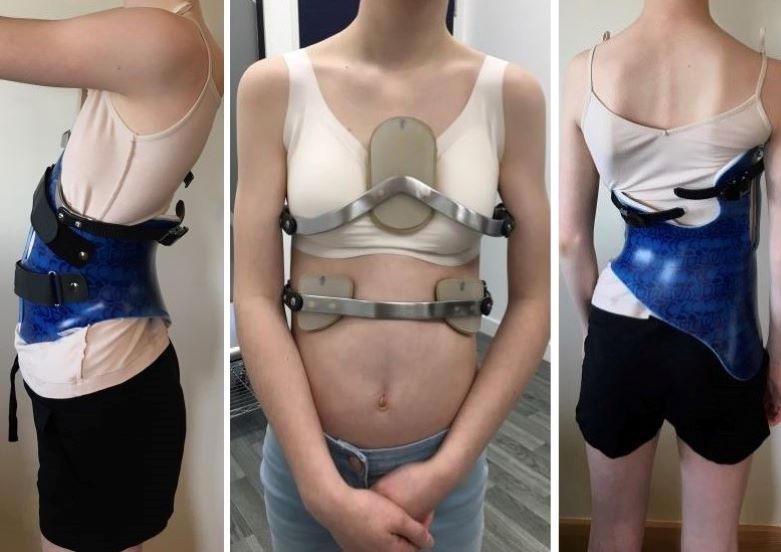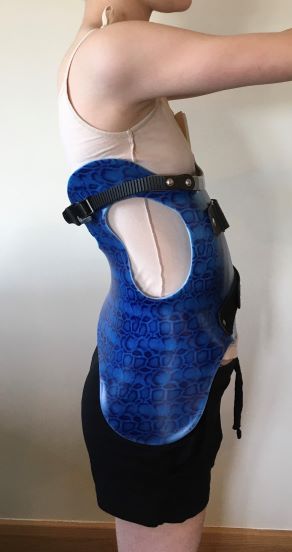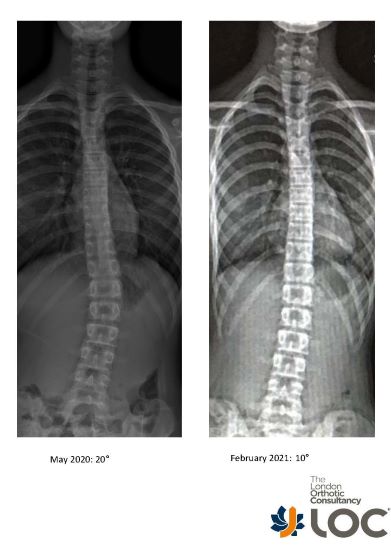
Above left: Daisy in her Cheneau-Gensingen brace. Middle: Daisy in her Pectus Carinatum brace. Right: Daisy’s scoliosis brace from behind
26 June 2021
It was initially in year three of school that Daisy’s mum, Sara, noticed something amiss with her posture. “I’m an orthopaedic physiotherapist, so I recognised that something was not quite right and suspected that we might be looking at scoliosis,” she explains. “Our GP referred Daisy to a consultant at the hospital where I work. They X-rayed her and diagnosed mild scoliosis of nine degrees. They also confirmed that she had pectus carinatum but advised that, as they considered this a cosmetic issue, we should simply monitor it and take no further action at that time.”
However, by late 2019, when Daisy was in year 7 (now aged 12), she herself started to express concern. “By that time, both scoliosis and the pectus looked more prominent and also displayed signs of rib flare. Plus, Daisy was starting to say that she worried about the way she looked,” Sara recalls. “So, at that point, I took her into LOC to see whether something could be done to help her. Sam (Sam Walmsley Founding Director at LOC) fitted her for a pectus chest brace in March 2020, after which a LOC Physiotherapist taught Daisy an exercise regime to help with the pectus deformity, but she was also interested in looking more closely at her scoliosis.”
“At the age of 10, I was diagnosed with mild scoliosis after concerns about my back. I was originally being seen by the NHS and monitored for about 3 years every six months. My scoliosis was slowly progressing but nothing too drastic and my NHS orthopaedic consultant told me that I would likely need bracing but not surgery. One night in winter 2019 my mum asked me whether I wanted to have my pectus carinatum sorted as I had been noticing it and feeling insecure about it for a while at this point. I said yes. I had previously seen a GP about it but they had said it was nothing to worry about; however, I was feeling particularly insecure about it.”
LOC began by prescribing a programme of exercises that Daisy could do at home, with the aim of monitoring whether these might prevent scoliosis from worsening, as well as supporting Daisy’s pectus bracing treatment. But, by May 2020, Sara was becoming more concerned and so, on LOC's advice, she arranged a scan at Harley Street. The results showed scoliosis that now measured between 20 and 22 degrees, meaning that Daisy’s curvature had more than doubled in 6 months.
“The pandemic meant that I couldn’t be treated on the NHS for my scoliosis so I had an EOS scan done at Harley Street and my scoliosis had almost doubled within 6 months bringing it to 22 degrees. This was still mild; however, it had a very high chance of progression so rather than wait to be treated on the NHS we opted for the Cheneau-Gensingen brace and physiotherapy at LOC.”
After further assessment at LOC, which showed scoliosis had a 60% chance of becoming even more acute, Sara and Daisy decided the time had come to fit a scoliosis brace. Given that Daisy was already wearing a brace for her pectus carinatum, an innovative solution was needed to treat both conditions simultaneously.
“I had my brace fitted and I was also given a personalised exercise programme to help with my 3D rotation. Not only was I wearing this new brace but I still had my pectus brace on and the amazing orthotists managed to combine the two so they worked together. I really struggled with this at first; however, I kept going and now I’m really glad I did. My scoliosis overcorrected by 10 degrees and I was able to reduce my scoliosis brace wear to 16 hours a day within 6 weeks.”

Above: Daisy’s Cheneau-Gensingen brace for scoliosis viewed from the side
LOC treats scoliosis with the LOC Scoliosis Brace – which also has the capacity to address rib flare. Our manufacturing team created a bespoke solution that enabled Daisy to wear the pectus brace over the top of her scoliosis brace to address both conditions. “Daisy initially wore the bracing for 22 hours a day,” says Sara. “Naturally, that was challenging for her. It’s not the most comfortable experience! But she persevered, as we knew it was important to undergo the treatment whilst her bones were still flexible. LOC offered fantastic support – they were always able to speak to us on Zoom or Skype if we needed advice and to see us in the clinic even during the pandemic. In particular, I was extremely impressed with the Covid-safe measures they have implemented. As a clinician working in a hospital myself, I felt they implemented exactly the protocols that I would expect in a medical environment. That was important to us – and I’m sure to all of LOC’s patients. When you are wearing an orthotic, there are always times when you are going to need to see your clinician face to face to deal with adjustments and that kind of thing. In my opinion, their care was the gold standard.”
“I really enjoyed going down to London and the orthotists were all really nice. There I had my pectus brace fitted and the adjustments made it more comfortable. Of course, I struggled with wearing that brace and it was uncomfortable at the start. However, I persevered and I eventually stopped noticing it was there and it just became part of my life.”
Daisy’s exercises have played an important part in her treatment. Sara was impressed with the quality of the programme LOC designed, and with her daughter’s tenacity in following the programme. “Daisy picked up on the exercises very quickly. She’s very astute, she could feel when she wasn’t doing the movements quite right and corrected that very quickly. All of the exercises could be performed at home, using things we had lying around the house like a towel rail, so it was feasible to stick to the programme without having to buy lots of expensive equipment.”
Fast forward to July 2020, and Sara and Daisy are thrilled with the results of Daisy’s follow up scan, which showed a slight overcorrection of scoliosis. “Daisy was so pleased,” says Sara,” because this meant that LOC could start to gradually reduce how long she needed to spend in her Cheneau-Gensingen brace each day. By the time she returned to school in September 2020, she didn’t have to wear the Cheneau-Gensingen brace during the day at all, but she still had to wear her pectus brace for 20 hours per day. At her most recent scan, her scoliosis was back down to 10 degrees, so LOC has completely corrected it. Daisy is much happier with the appearance of her chest as well – her carinatum was very one-sided, but now that asymmetry is hardly noticeable, and she only has to wear her pectus brace at night. The first consultant we saw estimated that she may have to wear a spinal brace until around the age of 18 – which would have been at least another four years. But LOC has achieved outstanding results for my daughter in less than a year. This kind of bracing treatment is not easy – it takes perseverance. But the combination of Daisy’s perseverance and LOC’s outstanding care has given us results we could not be happier with.”
“By February 2021, I was out of my scoliosis brace and only wearing my pectus brace for 16 hours. Currently, I am wearing my pectus brace for 12-14 hours a day and I am very happy with the results of my treatment. I am very grateful to all the amazing people at LOC and I want to thank them for helping me so much. In the year and a half since my treatment started, I have come so far and I am incredibly happy with the results and I am incredibly happy that I persevered.”
If you are concerned that your child may have a condition like pectus excavatum, pectus carinatum, or scoliosis, LOC may be able to help – even with unusual or multiple presentations. Just contact us to arrange an initial consultation with one of our orthotic team.

Above: Daisy’s scans in May 2020 and February 2021 show just how effective her bracing solution has been in correcting her scoliosis.
This depends on several factors; the position of the chest wall deformity, its severity, the flexibility of the chest, the kind of results wanting to be achieved and the age of the person undergoing treatment for pectus excavatum or pectus carinatum.
Early adolescence (roughly between the ages of 12-16 years old) – is an optimum age to start treatment, given that the chest is still maturing, and flexible, permanent correction is more easily achievable. Once bracing treatment is complete and a patient has stopped growing, the deformity will not return. For younger pectus patients, conservative bracing is used to keep a deformity from worsening and can help them to avoid surgery in later life.
For older pectus patients (between the ages of 20 to 30) results can be harder to achieve, as the costal cartilage hardens into the bone as a person matures. Over the years we have successfully treated many adults for both pectus excavatum and pectus carinatum and active adults with flexible chests can expect good results.
Again, this hugely depends on what a patient wants to achieve from treatment; whether that’s avoidance of surgery, improvement in the appearance of the chest shape, reduction in rib flaring etc. All these goals are taken into consideration during your first consultation. While there are no serious health risks of having pectus carinatum or excavatum – beyond the cosmetic – for many patients and parents, treatment outcomes involve improving confidence and self-esteem. During our 2018 Pectus Patient Survey, 92% of pectus carinatum patients surveyed said that treatment had a ‘major improvement’ or ‘an improvement’ on their social life.
You can read the results of our 2018 Pectus Patient Survey and quality of life questionnaire here.
Regular reviews are part of the treatment programme, preferably in clinic with one of our specialist orthotists, or via Skype consultations.
The number of appointments needed will vary from patient to patient but as a general rule, younger pectus patients who are growing at a faster rate will need to be seen more regularly for check-up appointments. This is to ensure that the brace fits well and is guiding the chest into the correct position as growth spurts occur. For other patients, this can be scaled back according to their individual needs and demands.
Regular appointments are beneficial for assessing progress, checking for signs of rubbing and determining whether another brace is needed. Appointments are also good for checking patient compliance to brace wearing and the breathing and exercise programme. At each appointment, we make time for patients to see our physiotherapist to fine-tune their exercise programme and check to see how a patient has been managing with the current programme.
We always advise coming in for appointments whenever you have any concerns about the brace or treatment programme, especially if a brace is rubbing or not fitting correctly. At the London Orthotic Consultancy, we have treated numerous international patients that have benefitted from specially designed braces that leave room to accommodate for growth and that can be adjusted remotely. Follow-up appointments for international patients are conducted via Skype.
This is a very common concern for patients considering treatment; in general, the dynamic chest compressor brace is easy to conceal if you are wearing a loose-fitting shirt for school or work. If you are wearing two chest braces – one for the main deformity and the other for rib flaring – then this may be more noticeable, especially under a t-shirt. Normally loose-fitting clothing will conceal the brace, though it’s likely it will be seen through tight-fitting clothes.
It is really important to continue exercising while going through bracing treatment. Exercise is fundamental to keeping the chest wall flexible. Our treatment programme incorporates a daily exercise routine of around 30-40 minutes of stretching using yoga poses, resistance bands, deep breathing exercises and general muscle stretches. Deep breathing exercises allow the lungs to expand against the chest wall, pushing it outwards.
Exercising with the brace on in the later stages of treatment can also make the chest correction more stable and permanent.
Swimming is one of the best forms of exercise to complement bracing treatment, as the body positions required to swim imitate the resistance band training designed to stretch the chest and increase its flexibility. Some swimming strokes are better for this than others, please check with your clinician. The brace should always be removed for contact sports and for swimming.
For most patients, one brace is often all that is needed to achieve a desired level of correction. They are each designed to last the duration of treatment and accommodate any growth that may occur in that time. Some patients have benefitted from having two braces – one to treat the main deformity and the other to treat rib flaring. For some pectus excavatum patients, having a brace apply pressure to the ribs – in addition to vacuum bell therapy – can greatly reduce the appearance of the depressed sternum area of the chest, forcing it upwards and outwards into a more corrective position.
If you are worried about your chest shape, or your child’s chest shape, then get in touch for a free Skype consultation with one of our pectus specialists who can assess their chest and discuss treatment options. We are always happy to communicate with local GPs, thoracic surgeons and consultants if a patient approaches us for bracing treatment after considering other options.